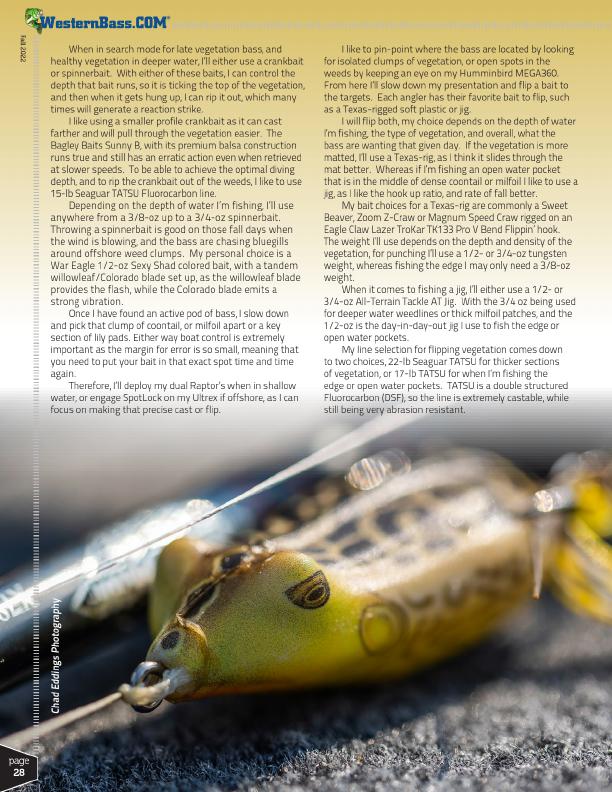
Fall 2022
®
When in search mode for late vegetation bass, and healthy vegetation in deeper water, I’ll either use a crankbait or spinnerbait. With either of these baits, I can control the depth that bait runs, so it is ticking the top of the vegetation, and then when it gets hung up, I can rip it out, which many times will generate a reaction strike.
I like using a smaller profile crankbait as it can cast farther and will pull through the vegetation easier. The Bagley Baits Sunny B, with its premium balsa construction runs true and still has an erratic action even when retrieved at slower speeds. To be able to achieve the optimal diving depth, and to rip the crankbait out of the weeds, I like to use 15-lb Seaguar TATSU Fluorocarbon line.
Depending on the depth of water I’m fishing, I’ll use anywhere from a 3/8-oz up to a 3/4-oz spinnerbait. Throwing a spinnerbait is good on those fall days when the wind is blowing, and the bass are chasing bluegills around offshore weed clumps. My personal choice is a War Eagle 1/2-oz Sexy Shad colored bait, with a tandem willowleaf/Colorado blade set up, as the willowleaf blade provides the flash, while the Colorado blade emits a strong vibration.
Once I have found an active pod of bass, I slow down and pick that clump of coontail, or milfoil apart or a key section of lily pads. Either way boat control is extremely important as the margin for error is so small, meaning that you need to put your bait in that exact spot time and time again.
Therefore, I’ll deploy my dual Raptor’s when in shallow water, or engage SpotLock on my Ultrex if offshore, as I can focus on making that precise cast or flip.
I like to pin-point where the bass are located by looking for isolated clumps of vegetation, or open spots in the weeds by keeping an eye on my Humminbird MEGA360. From here I’ll slow down my presentation and flip a bait to the targets. Each angler has their favorite bait to flip, such as a Texas-rigged soft plastic or jig.
I will flip both, my choice depends on the depth of water I’m fishing, the type of vegetation, and overall, what the bass are wanting that given day. If the vegetation is more matted, I’ll use a Texas-rig, as I think it slides through the mat better. Whereas if I’m fishing an open water pocket that is in the middle of dense coontail or milfoil I like to use a jig, as I like the hook up ratio, and rate of fall better.
My bait choices for a Texas-rig are commonly a Sweet Beaver, Zoom Z-Craw or Magnum Speed Craw rigged on an Eagle Claw Lazer TroKar TK133 Pro V Bend Flippin’ hook. The weight I’ll use depends on the depth and density of the vegetation, for punching I’ll use a 1/2- or 3/4-oz tungsten weight, whereas fishing the edge I may only need a 3/8-oz weight.
When it comes to fishing a jig, I’ll either use a 1/2- or 3/4-oz All-Terrain Tackle AT Jig. With the 3/4 oz being used for deeper water weedlines or thick milfoil patches, and the 1/2-oz is the day-in-day-out jig I use to fish the edge or open water pockets.
My line selection for flipping vegetation comes down to two choices, 22-lb Seaguar TATSU for thicker sections of vegetation, or 17-lb TATSU for when I’m fishing the edge or open water pockets. TATSU is a double structured Fluorocarbon (DSF), so the line is extremely castable, while still being very abrasion resistant.
Chad Eddings Photography
page 28